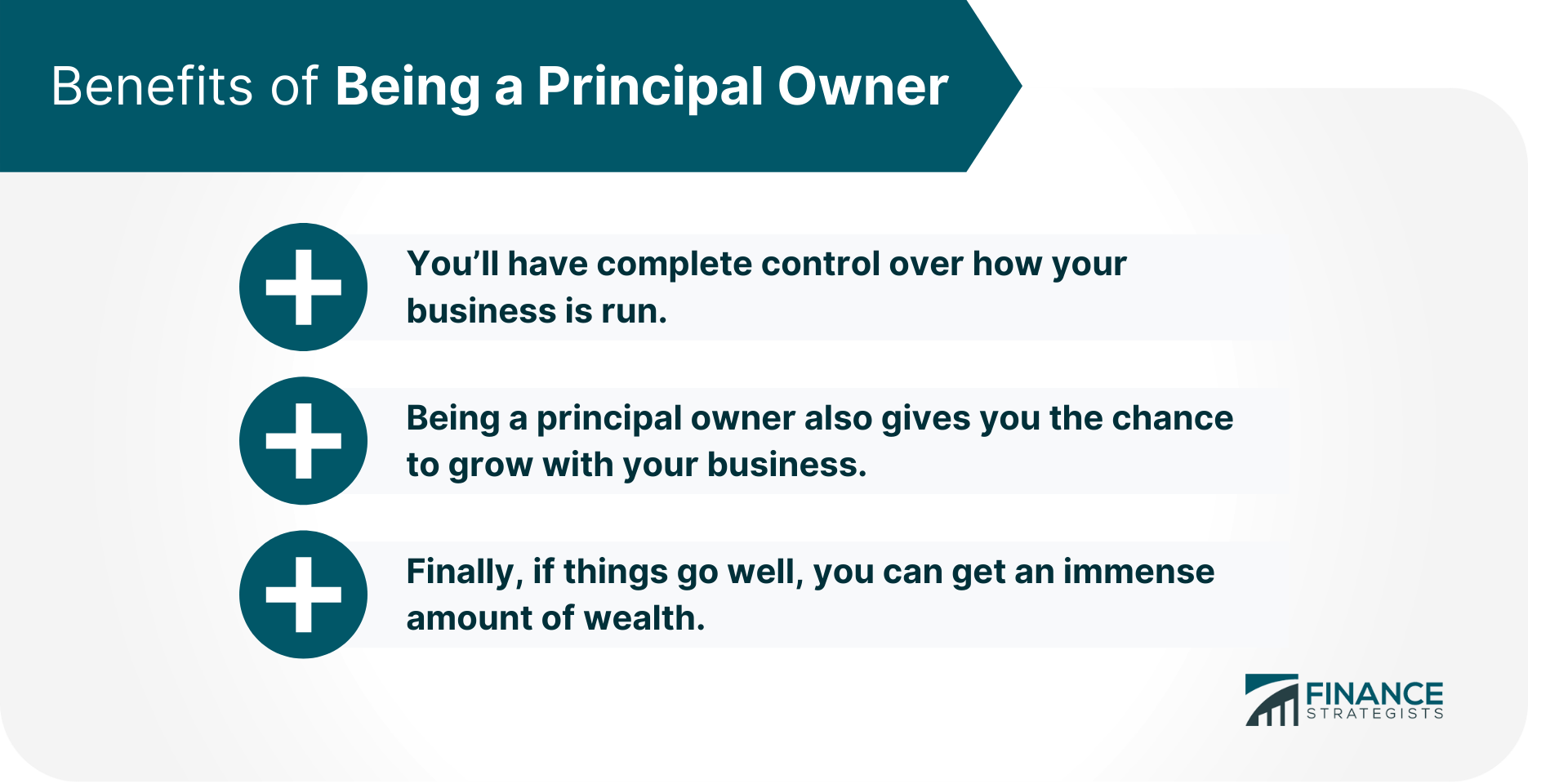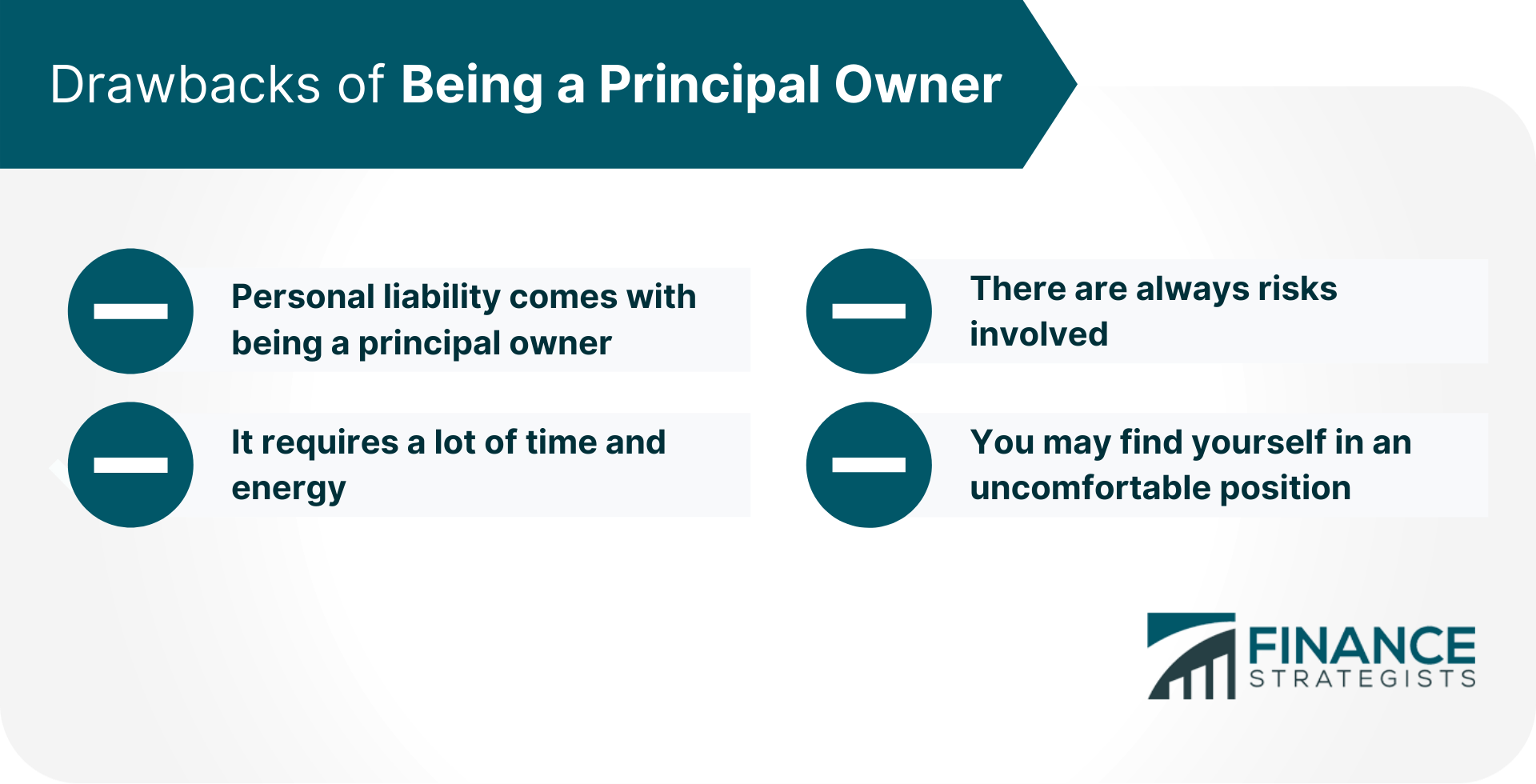A principal owner is one of several owners—shareholders or partners—in a privately owned business. They are responsible for the overall management of an organization, reporting directly to their shareholders or partners. The position does not come without risk; it's important that potential candidates understand the responsibilities involved before making the decision to become a principal owner. Most of the time, the principal is also the owner who receives the most money from their shares or partners. This is because the principal owner is the one who bears most of the responsibility for leading and managing the business. Principal owners have many responsibilities, some of which can be onerous. Here are just some of the many tasks that come with being a principal owner: They are usually in charge of overseeing all managerial functions, including staffing. Representing the company in front of investors who may provide capital. This usually includes giving a bi-weekly business update, monthly financial statements and quarterly reports. Setting fundraising goals and determining how to reach them, as well as advising the board on the best way to close a funding round. Formulating business strategies based on past performance, future potential and economic factors. This includes forecasting expenses, generating capital forecasts and managing cash flow. Attending board meetings, reporting to the board on a regular basis and making sure to follow all internal procedures. They are responsible for keeping track of financial transactions and filing tax returns. Additionally, principal owners may be tasked with overseeing human resources tasks. There are a few ways you can become a principal owner, but most common way is to: This may seem like the easiest and fastest way to be a principal owner, but it's not as easy as it seems, especially when there are other things on your plate. It takes time and energy to build an organization, so only do this if you're prepared to work hard. This is also another way to be a principal owner; all you have to do is invest in the business and become an owner. You could provide the capital needed for the business to begin running, or cash in if the business is already making profits. The last way to become a principal owner is to work for an existing company that has all or some of the following things: First of all, your hard work will be rewarded. Beyond that, there are other advantages to being a principal owner that you should note: There are disadvantages, too. Here are just some of them: There are benefits and drawbacks to being a principal owner, but those who've done it say the advantages far outweigh its disadvantages. If you're prepared to take on some risk and work hard, then becoming a principal owner is one option that may prove effective for you as well as your business. What Are Principal Owner Responsibilities?
Leadership Roles
Investor Relations
Reporting to Board of Directors or Advisory Committee
Raising Capital / Closed Periods
Financial Planning & Forecasting
Accounting & Legal Roles
Liaising with Tax Advisors
Human Resources Tasks
This means that they have to hire or fire employees, consult with HR managers regarding workplace issues and make changes that affect employee benefits.How To Become a Principal Owner?
Benefits of Being a Principal Owner

Drawbacks of Being a Principal Owner

Final Thoughts
Principal Owner FAQs
A principal owner is the person or entity that owns 50% or more of a company who has daily management responsibilities. He/she is responsible for making sure the day to day operations are running smoothly and efficiently.
A principal owner has three major responsibilities. These are deciding on the business direction, creating a culture within their business and helping with policy making.
There are 3 ways that an individual may become this type of owner: buying into an existing company, starting your own company or working for a company who offers this type of ownership to its employees.
Being a principal owner has many benefits. The main one is that you get to make decisions and help run the daily operations of your company. Another benefit is that you learn first hand how to manage people and resources. Finally, if things go well, you can become very wealthy because as a principal owner you have a greater share of the profits.
There are two main risks involved with being a principal owner. The first is that you will be personally liable if your business fails and owes money to creditors, so this leaves you open to losing everything that you have earned. The second risk is that being a principal owner is a full time job with no overtime, so you will be giving up other things in your life such as family and friends.
True Tamplin is a published author, public speaker, CEO of UpDigital, and founder of Finance Strategists.
True is a Certified Educator in Personal Finance (CEPF®), author of The Handy Financial Ratios Guide, a member of the Society for Advancing Business Editing and Writing, contributes to his financial education site, Finance Strategists, and has spoken to various financial communities such as the CFA Institute, as well as university students like his Alma mater, Biola University, where he received a bachelor of science in business and data analytics.
To learn more about True, visit his personal website or view his author profiles on Amazon, Nasdaq and Forbes.











